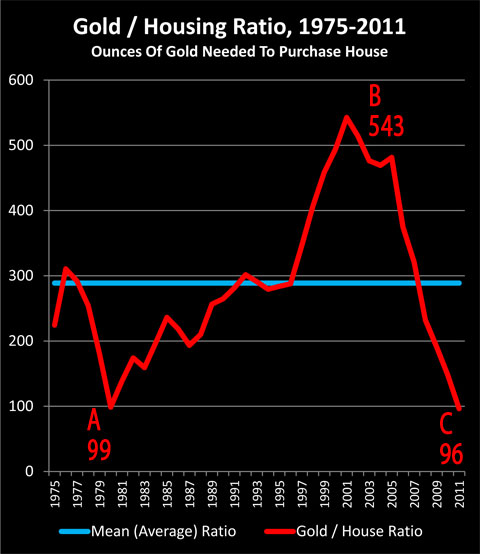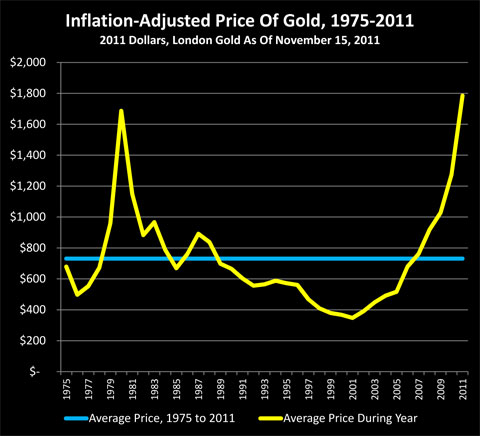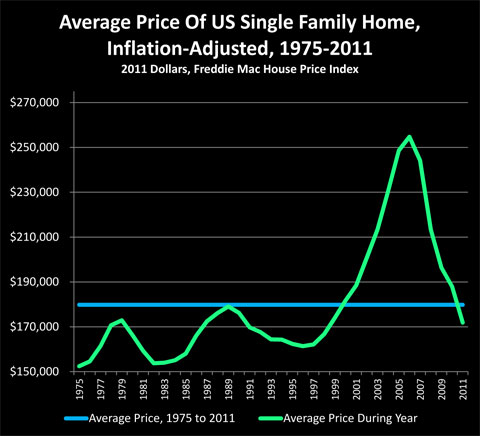Gold House Price Ratio Falls To Historic Low
Housing-Market / US Housing Nov 18, 2011 - 12:24 PM GMTBy: Dan_Amerman
 In gold terms, an average single family home in the United States can now be purchased for only 18% of its pre-bubble price in 2001. The term "pre-bubble" merits emphasis: the average house can be purchased at an 82% discount (in ounces of gold) not from the peak real estate values of 2006, but the much lower home prices of 2001, before the real estate bubble began.
In gold terms, an average single family home in the United States can now be purchased for only 18% of its pre-bubble price in 2001. The term "pre-bubble" merits emphasis: the average house can be purchased at an 82% discount (in ounces of gold) not from the peak real estate values of 2006, but the much lower home prices of 2001, before the real estate bubble began.
These numbers are based upon the Gold / Housing ratio, which is a measure of relative value between gold and real estate. When we take the $171,900 current median national price for an existing single family home (per the National Association of Realtors) and divide by the $1,785 price per ounce of gold as of November 15, 2011, we come up with a Gold / Housing ratio of 96, meaning it takes 96 ounces of gold to purchase an average single family home.
The graph below shows the Gold / Housing ratio for the entire modern era in the United States, from when gold investment was legalized on December 31, 1974 through current prices. This graph of relative value between the two investment classes shows how many ounces of gold it took each year to purchase an average single family home (adjusted for constant 2011 home size).

(Sources: For 1975-2010 the graph above uses annual average London price for gold as reported by Kitco, and the 2011 Q2 single family median home price (National Association of Realtors), modified by the annual average Freddie Mac House Price Index, which attempts to account for changes in average home size. 2011 numbers are November 15, gold, and Q2 house price (most recent available ) with the corresponding June house price index.)
In other words: let's net the dollars out, and go for direct comparisons.
People often buy gold and real estate as alternative investments, either because they are concerned about inflation, or they are seeking fundamental diversification from financial assets such as stocks and bonds.
However, while real estate and gold are each tangible assets and powerful inflation hedges - they don't tend to move together in real terms. When we adjust for inflation, both investments separately oscillate up and down around long term averages, and if you can buy gold "cheap" while real estate is relatively "expensive", then on an asset price basis over the long term, gold is likely to strongly outperform real estate as an investment and inflation hedge.
Conversely, when real estate is "cheap" and gold is "expensive" relative to their long-term averages - and each other - then it is real estate that is likely to powerfully outperform gold as an investment and inflation hedge over the long term, all else being equal.
But what exactly is "cheap" and what is "expensive"? Answering that question is where the Gold / Housing ratio graph above comes in.
The long-term average is represented by the blue line on the graph. Over the 37 years that gold has been a legal investment in the modern United States, it has taken an average of 289 ounces of gold to purchase an average single family home, meaning the current price of 96 ounces is only one third (33%) of the long term average.
As shown at "Point A", on an average annual basis, there was a previous modern ratio low of 99 ounces of gold to buy a house when gold reached its financial crisis peak valuation in 1980. Real estate was remarkably cheap relative to gold - and real estate investment would outperform gold by a huge margin over the 21 years to come.
"Point B" occurred in 2001, with the Gold / Housing ratio reaching a high of 543 ounces of gold being needed to buy a single family home. Gold was remarkably cheap relative to real estate - and gold asset prices would outperform real estate asset prices by a huge margin over the 10 years to come.
The current price of gold (as of November 15, 2011) is reflected in "Point C", which shows a Gold / Housing ratio of 96 ounces of gold being needed to buy the average single family home. This is only 18% of the 543 ounces required in 2001. Real estate is once again remarkably cheap, when compared to gold.
("Point C" is different from any of the other points in that it reflects currently available data for the price of gold, housing index and median single family housing price. It is therefore not an annual average ratio, and when in 2012 all the data eventually becomes available for 2011 the annual ratio will likely be lower, because gold spent most of the year at lower price levels. This means the annual average passing below 100 will likely not occur until 2012 - assuming current price levels remain, which is a big assumption in the current volatile times. Calculating a ratio that includes current market gold prices late in the year requires this necessary compromise, or else it becomes a lagging ratio with an annual update, with the full impact of the current price levels possibly not being available until early 2013.)
1980 & Gold As Investment
This next graph shows the average annual price of gold in inflation-adjusted (CPI-U) terms between when investing in gold bullion was legalized in the United States on December 31, 1974, and October 31st, 2011. The blue line is the average price of gold over that period, which is $730 in 2011 dollars. The yellow line is the average annual price of gold during each year (except for 2011, where it is the value as of November 15).

It is worthwhile to consider the situation in 1980. Inflation was soaring. Unemployment was high. An economic "malaise" gripped the nation, and pessimism about the future of the United States was rampant. The stock market was moving between flat and down. The real estate market was in terrible shape.
The one glittering exception was gold, which was soaring upwards in a spectacular bull market and reaching unprecedented levels - and which many people believed would only be a beginning point, as the dollar continued to fall and the economy continued to worsen. There was a new gospel of gold investing as an inflation hedge that would bring great wealth.
However, from that point forward - gold did not perform or meet expectations. In nominal dollar terms, the average price of gold fell from $613 in 1980 to $271 in 2001, a loss of 56%.
What is worse is that although the theory was that gold would be the perfect inflation hedge, in practice over the long term, gold failed spectacularly as an inflation hedge, at least from the perspective of gold purchased in the three peak years of 1979-1981. The inflation didn't stop after 1980 - the official rate of inflation was 10.5% in 1981, the 3rd highest rate of the modern era in the US - but gold investors still lost 32% in that first year after the peak, in inflation-adjusted terms. Gold gave up all of its gains relative to its long term modern average of $730 per ounce by 1985, five years after its peak.
Between 1980 and 2001, the time of the next Gold / Housing inflection point, the dollar would lose half of its value to inflation. Gold did not keep up, however, collapsing from $1,687 down to $347 per ounce (2011 dollars) over 21 years as it lost 80% of its value in inflation-adjusted terms.
(It should be noted that the $730 per ounce modern era average price is based on a relatively short 37 year period of time, which included a purely paper US dollar and two major crises, and is itself unusually high by long term standards. As an example of a longer term, multi-century measurement, gold averaged $458 an ounce (in 2009 dollars) between 1791 and 2009, although inflation measures grow increasingly unreliable the farther back in time one goes.)
1980 & Real Estate As Investment
The graph below shows the average price of a single family home in inflation-adjusted (CPI-U) terms from 1975 through the 2nd quarter of 2011, with a mean (average) price of $179,820 in 2011 dollars. As noted in the Freddie Mac index discussion at the end of the section, this is based upon an average size existing house for 2011, which is considerably larger than the average existing house in 1975, but this adjustment is necessary if we are to accurately compare "like to like" in tracking real estate values.

In the mind of the general public in 1980, real estate was a total "dog" of an investment and had been so for years. Some people were turning down promotions if they involved a move, because the raise associated with the promotion often wasn't high enough to offset the radically higher mortgage payments. Many people who would have ordinarily bought homes were renting instead, fearful of how much worse conditions might be when they tried to sell. The combination of recession, high unemployment and inflation-induced high interest rates had created a moribund real estate market, with low sales and greatly reduced new home construction.
These highly negative market conditions created a pricing situation in which real estate was only being valued at 34% of its long-term average value relative to gold, meaning real estate was extremely "cheap" in comparison - and ready to move the other way.
Indeed, from this base of near universal disdain came a remarkably healthy and sustained long-term environment for building wealth via buying investment real estate. Using single family homes as a proxy (investment real estate overlaps, but is not the same thing), in nominal or normal dollar terms, the average price for a single family home in the United States rose every year for the next 21 years from $60,408 to $147,102 (no inflation adjustment). This 144% increase occurred between points A & B in our Gold / Housing ratio graph, and therefore did not include any benefit from the housing bubble.
Inflation was the largest component of this rise, and unlike gold, housing performed as a powerful inflation hedge for the next two decades. Even after adjusting for inflation, during the same period that gold fell 80%, housing rose from $166,342 to $188,467, an increase of 13%. (The decline shown from 1980-1982 in the graph does not exist if we use nominal dollars, which is the norm, it only appears when we adjust for inflation.)
If we take the long term perspective of real estate investments generating steady performance, where cash flows increase every year as rental payments coming in steadily rise relative to mortgage payments going out, even as equity increases every year as overall property prices steadily rise while the mortgage slowly falls - then the years between the turning points of 1980 and 2001 were a wonderful time to be a long term real estate investor. Sure, there were dips and rises and crises as happens with almost any investment category over the long term, but the years between 1980 and 2001 were a great time to accumulate wealth as a long-term real estate investor.
Going back to the relationships underlying the Gold / Housing ratio, as each inflation hedge separately moved up and down around their long term averages, and real estate went from being relatively very cheap compared to gold, to being very expensive, then we would expect real estate to radically outperform gold over that time. Indeed, that is exactly what happened, and the 21 years (1980 - 2001) following the last time the ratio was at 99, real estate asset prices outperformed gold by 448%.
(The house price is calculated using the median national price of a single family home for the 2nd quarter of 2011 of $171,900, as reported by the National Association of Realtors. This price is then adjusted backwards using both an inflation index and a housing price index. The inflation index utilized is the Consumer Price Index (CPI-U), as reported by the Bureau of Labor Statistics. The housing index used is the Freddie Mac House Price Index, rather than the more commonly used S&P / Case-Schiller Index. Like the S&P / Case-Schiller index, the Freddie Mac index uses a "pairs" methodology to account for changes in average house size and amenities over the years; however, the Freddie Mac index uses more widely distributed geographic data.)
Gold & Real Estate In 2001
By 2001, the relationship between gold and real estate had entirely reversed, as the Gold / Housing ratio reached a historic high of 543 ounces of gold to buy an average home.
Gold was a total dog of an investment. Real estate was hot. The overwhelming market sentiment, and what most financially savvy people believed, was that real estate was a far superior investment to gold.
It was precisely the overwhelming consensus of opinion among intelligent, knowledgeable investors, and some of the most respected financial experts in the nation, which created the situation where real estate was very "expensive" relative to gold.
In contrast, if we take the long term perspective of relative value, with real estate far above its historic average value relative to gold, meaning it took 543 ounces to buy a house in 2001, one would expect gold to then powerfully outperform housing - and that is exactly what happened over the following ten years, from 2001 to 2011.
Over the next ten years, gold would rise from $271 an ounce to $1,785 an ounce, even while real estate rose from about $147,102 to about $171,900 for a single family home. Adjusting for inflation, gold rose from $347 an ounce to $1,785, while housing fell from $188,467 to $171,900.
This serves as another confirmation of the central premise of the Gold / Housing ratio, which is that if you can buy an inflation hedge "cheap", then over the long term you are likely to widely outperform an inflation hedge bought "expensive", given that both gold and real estate move up and down around long-term average values.
There are also a couple of other fascinating features of the 2001 peak. The bottom price for gold in inflation-adjusted terms in the modern era occurred in 2001, when the Gold / Housing ratio peaked. The peak price for gold in inflation-adjusted terms in the modern era occurred in 1980, when the Gold / Housing ratio bottomed.
There is an exact correspondence when we look at the peak and bottom values for gold in inflation-adjusted dollar terms, and the peak and bottom values when we view gold in real estate terms.
It is also worthwhile to note that the Gold/Housing ratio did not call the peak in the real estate bubble, far from it. Instead, this ratio of relative values said that real estate was starting to get historically expensive compared to alternative investments right at the very time that the bubble was just starting to make an appearance. So the value of the ratio was not speculative timing within a bubble - but rather was a signal to long-term investors to sit out the bubble altogether.
Market Sentiment & Generational Buying Opportunities, A Powerful Case For Gold, Reconciling The Opportunities
The second half of this article can be read at the link below. Highlights include: 1) assessing the true usefulness of the Gold / Housing ratio and whether it can identify generational buying opportunities; 2) the compelling case for gold in the event of currency meltdown, which may make temporarily obsolete the recent modern history of the ratio; and 3) how to reconcile these two sides of contrarian investing, when "buy low & sell high" is in such powerful conflict with possible financial meltdown.
By Daniel R. Amerman, CFA
Website: http://danielamerman.com/
E-mail: mail@the-great-retirement-experiment.com
Daniel R. Amerman, Chartered Financial Analyst with MBA and BSBA degrees in finance, is a former investment banker who developed sophisticated new financial products for institutional investors (in the 1980s), and was the author of McGraw-Hill's lead reference book on mortgage derivatives in the mid-1990s. An outspoken critic of the conventional wisdom about long-term investing and retirement planning, Mr. Amerman has spent more than a decade creating a radically different set of individual investor solutions designed to prosper in an environment of economic turmoil, broken government promises, repressive government taxation and collapsing conventional retirement portfolios
© 2011 Copyright Dan Amerman - All Rights Reserved
Disclaimer: This article contains the ideas and opinions of the author. It is a conceptual exploration of financial and general economic principles. As with any financial discussion of the future, there cannot be any absolute certainty. What this article does not contain is specific investment, legal, tax or any other form of professional advice. If specific advice is needed, it should be sought from an appropriate professional. Any liability, responsibility or warranty for the results of the application of principles contained in the article, website, readings, videos, DVDs, books and related materials, either directly or indirectly, are expressly disclaimed by the author.
© 2005-2022 http://www.MarketOracle.co.uk - The Market Oracle is a FREE Daily Financial Markets Analysis & Forecasting online publication.



